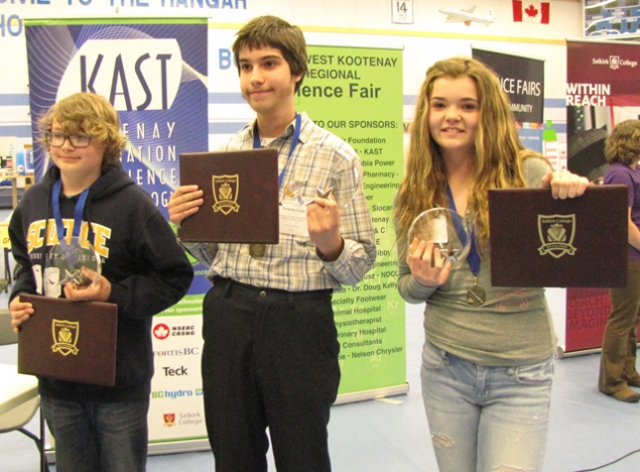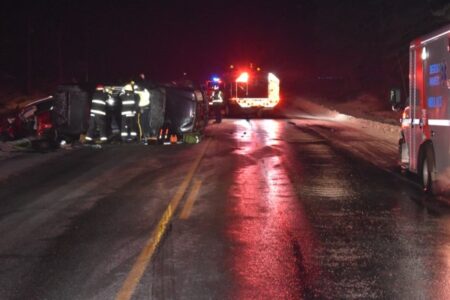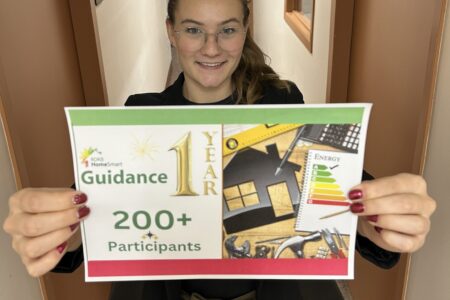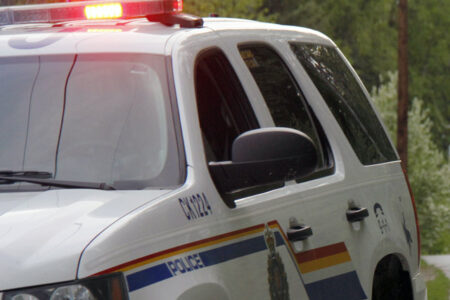Student Scientists show their stuff at Regional Science Fair
Nicholas Paun, Dylan Peil and Ivie Lock‐Luttmer proved that science can be fun after the trio rocked the KAST (Kootenay Association for Science & Technology) fair Saturday at the L.V. Rogers Gymnasium in Nelson.
The trio are now off to Fredricton, NB, for the Canadian Science Fair May 14-16.
Paun and Peil have racked up numerous awards for their innovations in science and have twice qualified to represent the West Kootenay & Boundary at the Canada‐wide science Fair.
In 2015, they will be joined by Lock‐Luttmer, the grand prize regional fair winner having won three individual awards as well as qualifying to travel to the national fair this year.
The 2015 regional student science fair featured 86 projects from almost 100 participants from across the Kootenay Boundary region and included students from the Kootenay Lake (#8) and Kootenay‐Columbia (#20) School Districts.
Paun, a Grade 11 student at Mt. Sentinel School, entered his second edition Chemlogic: A Logic Programming Chemistry System and won the BCIC Young Innovator Scholarship ($2,000), a Selkirk College Scholarship
($500), and Gold in the Senior Innovation Division.
Trafalgar Middle School’s Peil, in Grade 8 designed and prototyped a Solar Concentrator using a satellite dish covered with mirrors.
His efforts netted him the Nelson Hydro Award ($100), Association of Professional Engineers & Geoscientists of BC Award ($100), a Selkirk College Scholarship ($200) and Gold in the Junior Innovation Division.
The surprise of the fair, Lock‐Luttmer won Gold in the Junior Research Division for her research on Dead Zones. The Grade 7 student at Trafalgar also won the BC Nature Award ($100), the WE Coates Award ($200) and will be joining Paun and Peil for the Canada‐wide fair.
This year’s regional science fair was a success for many others as well, with eight other students winning individual awards and 63 students winning gold, silver or bronze in the research, experiment or innovation categories.
Of special note, Katie Clarke, in Grade 2 at Webster Elementary, spoke to judges via phone from the hospital after she experienced temporary paralysis due to a tick bite. Clarke’s project,
The Magic Eye, and her knowledge of the subject matter won her the gold medal in the Grade 2 Research division despite the setback.
Clarke’s siblings also entered the fair, with Charles winning a silver medal in the Kindergarten/Grade 1 Experiment Division, and James and Madeline winning Silver in the Grade 6 Innovation Division with Can Lego Be Sorted?
Other sibling winners included Nadine and Hayden Persad; Ify, Chinedu and Chinemelum okonkwo; Felix and Oscar Willems; Sophie and Georgia Byrne; Oliver and Spencer Ridge; Caleb and Nathaniel Poulter; and Dylan and Caleb Peil.
Schools represented at the fair included, from Kootenay Lake – Trafalgar Middle, Mt. Sentinel Secondary, South Nelson Elementary; Blewett Elementary; and Wildflower; Nelson Christian Community School; St. Joseph School; and Heritage Christian Online School. From Kootenay Columbia, participating schools were St. Michael’s School; Webster Elementary; Ecole de Sept Sommets; Glenmerry Elementary; Adam Robertson Elementary; Rossland Secondary; and Kinnaird Elementary.
KAST is providing $2,275 in funding to assist the students with travel to Fredricton for the 2015 Canada‐wide Science Fair.
Hundreds of the country’s brightest young scientific minds will attend this year’s event, competing for medals, cash awards, scholarships and other prizes worth approximately $1 million.
KAST is a registered non‐profit society advocating for science and technology in the West and Central Kootenay and Boundary regions. KAST members live and work in the region, and represent a broad range of interests in local industry, business, education and government.
KAST GLOWS is part of a long‐term economic development strategy that strengthens youth interest and engagement in science and technology, encouraging youth to pursue science and technology education and careers. Investing in youth and supporting their pursuit of careers that can strengthen our regional economy is the ultimate impact of the GLOWS program.
























Comments